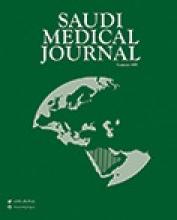Abstract
OBJECTIVE: The aim of this communication was to study the clinical pattern of acute pancreatitis with special reference to aetiology, severity, seasonal variation and outcome in the high altitude region of Asir.
METHODS: This is a cross-sectional, hospital-based study. All consecutive cases of acute pancreatitis admitted to Asir Central Hospital, Abha, Saudi Arabia over a two and half-year period (May 1996 - October 1998) were included. Clinical and laboratory data were analyzed to determine the severity of the attack according to Ranson's criteria.
RESULTS: There was a total of 73 attacks of acute pancreatitis in 69 patients. Mean patient age was 51.01 years (range = 13-120 years) and the male to female ratio was 0.6:1. In 68.5%, gallstones were the associated cause and idiopathic acute pancreatitis was diagnosed in 25%. Using Ranson's severity prediction criteria, 44% of the attacks were classified as "severe", but only 22% of the patients so classified developed complications. Pseudocysts and Pancreatic abscess complicated three cases. Complications were significantly correlated with cold seasons (P=0.04), intervention by Endoscopic retrograde cholangiopancreatography (P=0.02) and severity (P=0.02).
CONCLUSION: This study revealed that acute pancreatitis seen in Asir region is predominantly biliary-associated and is more frequent in females. Although near half of the attacks were classified as severe pancreatitis, according to Ranson's criteria, complications occurred in only 22% of the attacks and this may indicate that Ranson's criteria needs to be modified before application in our setting.
- Copyright: © Saudi Medical Journal
This is an open-access article distributed under the terms of the Creative Commons Attribution-Noncommercial-Share Alike 3.0 Unported, which permits unrestricted use, distribution, and reproduction in any medium, provided the original work is properly cited.






